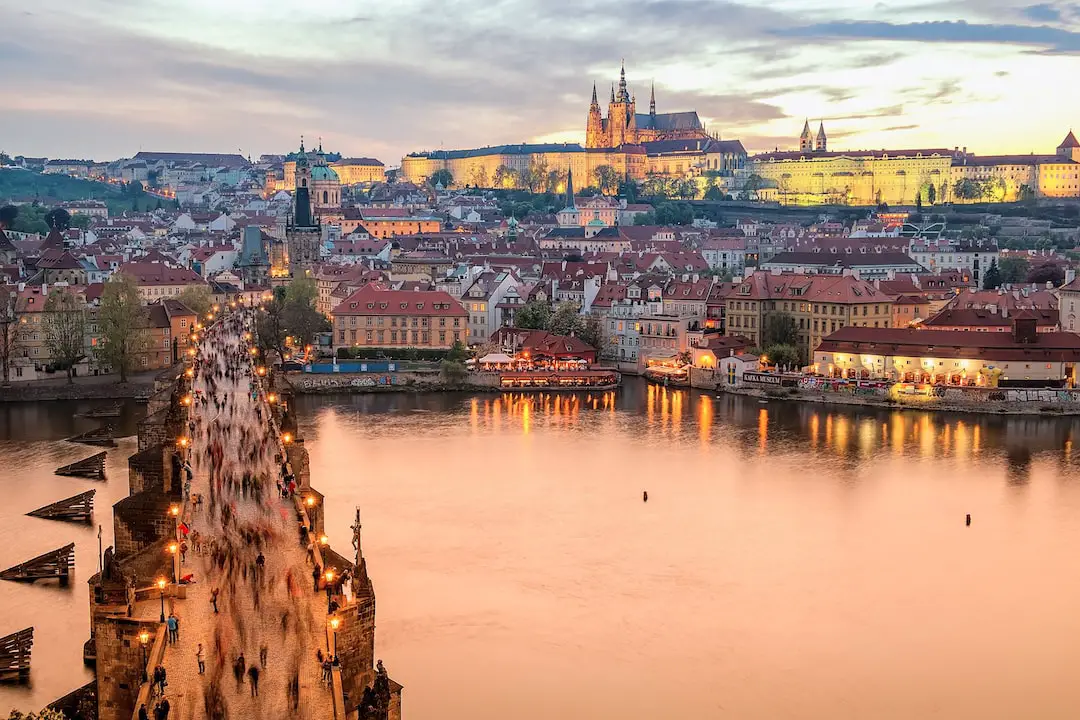
Imagine strolling through the cobblestone streets of Prague, where every corner tells a story, and every building is a testament to the city’s rich tapestry of history. Prague’s architecture is like an open book, chronicling the evolution of design from the Romanesque grandeur of the Basilica of St. George to the modernist curves of the Dancing House. Let’s embark on a journey through time, exploring how the architecture of Prague, Czech Republic, has transformed from its past to the present.
The Dawn of Prague’s Architectural Journey
The story of Prague’s architecture begins in the 9th century with the construction of Prague Castle. This sprawling complex set the stage for the city’s architectural narrative. The Romanesque style, characterized by its thick walls and rounded arches, laid the foundation for Prague’s early structures. The Basilica of St. George, with its robust appearance, is a prime example of this era’s enduring legacy.
Gothic Grandeur and Celestial Spires
As we leap forward to the 14th century, the Gothic style took center stage. The reign of Charles IV brought about a cultural renaissance, and with it, the construction of iconic landmarks. The Charles Bridge, with its pointed arches and Gothic guard towers, became a symbol of the city’s burgeoning prestige. The St. Vitus Cathedral, with its soaring spires, remains a masterpiece of Gothic architecture, drawing visitors from around the globe.
Renaissance and Baroque: A Flourish of Elegance
The Renaissance era ushered in a wave of humanism and artistry. Prague was no exception, as architects began to embrace symmetry, proportion, and classical detail. The Summer Palace of Queen Anne, also known as Belvedere, is a jewel of Renaissance architecture, showcasing intricate sgraffito decorations.
Baroque architecture soon followed, sweeping through Prague with its dramatic flourishes and grandeur. The St. Nicholas Church in the Lesser Town is a baroque treasure, its interior a symphony of frescoes, stucco, and gilded details. The palaces and gardens of this period continue to enchant, reflecting the opulence of the time.
Neoclassicism to Art Nouveau: Aesthetic Evolution
As the 18th century waned, neoclassicism took hold, bringing with it a return to the simplicity and elegance of classical antiquity. The Estates Theatre, where Mozart’s “Don Giovanni” premiered, exemplifies this style with its clean lines and harmonious proportions.
By the turn of the 20th century, Art Nouveau’s organic forms and decorative motifs began to appear throughout Prague. The Municipal House is a testament to this, with its stunning facade and interiors designed by renowned artists of the time. Its blend of functionality and beauty speaks to the innovative spirit of the era.
Modernism and Beyond: Breaking Boundaries
The 20th century saw Prague embracing modernism, with architects like Josef Gočár and Adolf Loos leading the charge. The Rondocubist House of the Black Madonna and Loos’ minimalist Villa Müller stand out as bold statements of the time.
Postmodernism made its mark in the late 20th century, with the Dancing House, co-designed by Frank Gehry, becoming an icon of contemporary Prague. Its deconstructivist form challenges traditional aesthetics, yet somehow fits seamlessly into the city’s eclectic skyline.
Prague’s Architecture Today: A Fusion of Past and Future
Today, Prague continues to honor its architectural heritage while embracing innovation. The city’s skyline is a mosaic of historical periods, each contributing to the unique character of the Czech capital. New developments respect the past, often incorporating sustainable practices and modern design principles.
FAQs About Prague’s Architecture
- What is the most iconic example of Gothic architecture in Prague?
The St. Vitus Cathedral is the most iconic Gothic structure in Prague, known for its stunning stained glass windows and towering spires.
- Can you see different architectural styles in Prague?
Absolutely! Prague is a melting pot of architectural styles, from Romanesque and Gothic to Renaissance, Baroque, Art Nouveau, and modernist influences.
- Is Prague’s modern architecture well-received?
While Prague cherishes its historical architecture, modern structures like the Dancing House have been embraced for their innovative designs and have become landmarks in their own right.
Conclusion: The Architectural Tapestry of Prague
In conclusion, Prague’s architecture is a vivid narrative of history’s ebb and flow. From the Romanesque fortitude of its early days to the modernist innovations of the 20th century, each style has left an indelible mark on the city’s identity. As we’ve wandered through the ages, we’ve seen how Prague has skillfully woven the threads of its architectural past into the fabric of its present, creating a cityscape that’s as rich and varied as the history it represents.
For those enchanted by the evolution of design, Prague stands as a testament to the enduring power of architecture to tell our collective stories. It’s a city where the past is always present, and every building is a chapter in a much larger tale. So, whether you’re a real estate investor, a homeowner, a first-time home buyer, or a real estate agent, remember that Prague’s architecture isn’t just about structures; it’s about the soul of a city that has stood the test of time.
As we look to the future, we can only imagine what new architectural marvels will rise from the storied grounds of Prague. But one thing’s for sure: they’ll be part of a legacy that’s as timeless as the city itself. So, let’s raise our glasses to Prague, a city where architecture is more than just buildings—it’s the heartbeat of history.